Predicting All-NBA 1st, 2nd and 3rd Teams
Dan Favale@@danfavalePredicting All-NBA 1st, 2nd and 3rd Teams

A lot has changed since we last took a stab at predicting the three 2023-24 All-NBA teams. Too much, arguably.
Sure, the lion's share of the first team should look the same. But is the final spot (or two) really beyond debate?
Good luck searching for any semblance of consensus on the final 10 spots across second-team and third-team honors. A handful of names are "must-includes." But where? And who gets the most painful shaft(s)?
Looming over all this more than ever, meanwhile, are the new eligibility requirements. Players must be on track to appear in 65 games (with scant few exceptions) to get the official nod.
That so far removes Scottie Barnes, Jimmy Butler, Joel Embiid, Kyrie Irving, Jamal Murray, Lauri Markkanen, Donovan Mitchell, Kristaps Porziņģis, Julius Randle and Trae Young. Karl-Anthony Towns just became ineligible (as expected). Devin Booker looks like he'll make the cut but doesn't have a huge margin for error. Alperen Sengun will end up being eligible because he met the criteria for exception prior to his ankle injury. Will that matter?
As a quick reminder: Explanations for these picks will mostly be dedicated to propping up candidates. But this exercise will—because it must—explore why certain names fall behind others or don't make the final cut. Please do not interpret devil's advocacy as a personal vendetta or deliberate oversight. This stuff remains hard.
At its core, this is basically my read entering Monday's games on the 15 best players from the 2023-24 regular season—relative, of course, to the new eligibility requirements. What's changed since we last pored over All-NBA possibilities? Time to find out.
1st Team: Nikola Jokić, Denver Nuggets

Previous: First Team
Look, I'll be honest, I'm running out of ways to describe and contextualize Nikola Jokić's impact. He is the most airtight lock among four first-team guarantees, yet again having a season that boggles the mind, eyes and box score.
He's about to wrap his third season averaging north of 25 points, 10 rebounds, seven assists and one steal. Everyone else throughout league history has hit those benchmarks a combined two times. (Russell Westbrook has all two of those campaigns.)
Perhaps the best way to frame his play is through the MVP lens.
At a time when Giannis Antetokounmpo, Luka Dončić and Shai Gilgeous-Alexander are putting together bonkers campaigns worth their own Michael Jordan trophy, Jokić has turned the race into a formality, the kind of certainty that makes it impossibly hard to envision alternate outcomes. That's, uh, ridiculous.
Skeptics, contrarians, those suffering from greatness fatigue, whatever, may argue that Jokić benefits from a narrative bump. It was determined long ago, just after the Joel Embiid meniscus injury, that the MVP landscape came down to him and Gilgeous-Alexander, ostensibly closing the door on Antetokounmpo and Dončić. Bake in a post-All-Star slump from SGA (by his standards), and poof! Here we are.
Traces of this could be at play. It is not the crux of Jokić's MVP candidacy—far from it. There is not another first-team option or, frankly, player in the league who elevates and optimizes those around him like the soon-to-be three-time MVP.
1st Team: Shai Gilgeous-Alexander, Oklahoma City Thunder

Previous: First Team
Shai Gilgeous-Alexander's place in the MVP hierarchy is more debatable than it's been at any other point this year. He has seen his efficiency from distance and free-throw volume take a post-All-Star-break dive.
Whether this should be attributed to his quad injury, the obvious shift in officiating or both is almost irrelevant. This bound-to-be-temporary slump is ill-timed. Giannis Antetokounmpo and Luka Dončić are buh-alling.
Just so we're clear: Splitting hairs over whether SGA belongs second or third or fourth on the MVP ballot is a gosh damn luxury. He could not play another minute or make another three, and his All-NBA first-team case would remain something stronger than ironclad.
The extreme to which Gilgeous-Alexander bends defenses, even when he's not operating at his peak, is beyond measure. New Orleans Pelicans TV color analyst Antonio Daniels recently described SGA as, basically, putting opponents and entire systems in a constant state of retreat—which is just so darn perfect:
A recent backslide has done little to detract from SGA's gaga numbers. Just five other players have ever cleared 30 points, six assists and two steals: Rick Barry (1974-75), Stephen Curry (2015-16), Allen Iverson (2004-05), Michael Jordan (three times!) and Dwyane Wade (2008-09). SGA's true shooting percentage ranks second among these seasons, trailing only that of unanimous-MVP Steph.
1st Team: Giannis Antetokounmpo, Milwaukee Bucks

Previous: First Team
Giannis Antetokounmpo continues to be the pinnacle of nonsensical. His numbers, like always, don't so much bend the brain as blow it to smithereens.
Averaging over 30 points, 11 rebounds and six assists (career high) to go along with roughly a steal and block is just stupid. It's also right in line with what he's done since 2019-20: upkeep the impossible while somehow baking in incremental improvement.
Harping on his play invariably leads you down the MVP rabbit hole. There's a real chance he'll finish outside the top two in voting for a fourth consecutive season, a nod more so to the supernatural capabilities of his contemporaries than an injustice, but a soul-scrambling reality all the same.
But let's not detour any further. Giannis deserves a ton of credit for cleaning up his shot diet, refining his vision and scoring at a career-best clip inside the arc while navigating a developing dynamic alongside Damian Lillard that still isn't a portrait of total predictability, let alone perfection.
The defensive impact endures, even if Giannis' energy seemingly waxed and waned to start the season. And he deserves a medal for ferrying units without both Dame and Brook Lopez to a net-positive on the season. Dig through some of those combinations, and it's a minor miracle they've managed to tread water defensively, even if they remain a rung or two below average.
Essentially, Giannis keeps doing, keeps growing, enough to retain his spot among a hyper-competitive superstar pecking order. A couple of players can finish ahead of him on the MVP ballot during any given season. In the aggregate, though, there's just one other name better equipped to sustain unflappable, unmatchable dominance.
1st Team: Luka Dončić, Dallas Mavericks

Previous: First Team
Welcome to the best version of Luka Dončić we have ever seen, a singular force who still represents a top-five-to-seven offense unto himself but also knows more than ever to work in tandem with other ball-dominance.
Like usual, the numbers speak for themselves. Dončić is spitting out almost 34 points per game to lead the NBA and dishing close to 10 assists, all while maintaining efficiency that belies the degree of difficulty with which he plays.
This marks the fifth consecutive season that he's tallying a true shooting percentage comfortably above league average. And he lands in the green despite almost 80 percent of his made buckets going unassisted—the highest share among close to 500 players who have appeared in more than 10 games.
Not surprisingly, he's downing over 38 percent of his step-back triples. He also paces the Association in self-created threes, per PBP Stats—by roughly a 50-shot margin.
I can't tell what's more impressive: The general absurdity or how routine this absurdity has become.
And yet, Dončić has also developed an enviable chemistry with Kyrie Irving. The latter has made a majority of the functional tweaks, but Luka is playing faster and the share of buckets that go unassisted, while still sky high, is at its lowest since 2018-19...when he was a rookie.
Totally inflexible, he is not.
1st Team: Kawhi Leonard, Los Angeles Clippers

Previous: First Team
We will now resume our regularly scheduled "Kawhi Leonard or Jayson Tatum?" dilemma for the final first-team slot.
Screenshot-without-including-a-link-or-context social media users were pretty pissed that Kawhi edged out Tatum last time. That (probably) won't change now.
And you know what? That's fair! This is, to me, a genuine toss-up. Most catch-all metrics will say the same—while ultimately giving the slight edge to Leonard.
Efficiency and the scope of defensive roles are my deciding factors.
Tatum shoulders the heavier workload on offense. That accounts for some of the efficiency gap. But Leonard has the lower shot quality, according to PBP Stats, and is averaging 1.20 points per isolation possession to Tatum's 1.06.
Volume, rim frequency and foul-drawing in one-on-one situations favor Tatum. Both have iffy clutch splits. Kawhi is shooting at a better clip on drives. He has the advantage on pull-up jumper efficiency as well.
This really comes down to whether you believe there's a measurable defensive chasm between the two. I do. Tatum cannot be penalized for having much (much) better teammates on the less glamorous end. Kawhi spends more time on tougher covers because, even with Paul George in tow, he has no choice. But he's capable of shutting down players and entire systems, both on the ball and as a helper, at a level Tatum has yet to reach, let alone sustain.
Once more, with added feeling: This could go either way. Choosing Kawhi isn't a slight at Tatum. He could very well seize this spot when we meet again, one more time, at the end of the regular season.
Speaking of which...
2nd Team: Jayson Tatum, Boston Celtics

Previous: Second Team
I can't really blame anyone who interprets this as disrespect to Jayson Tatum. Debating whether he's something like the fifth- or seventh-most impactful player of the season invariably turns into a referendum on his negatives.
Those downsides are harder to grasp now.
Tatum's spotty shooting in crunch time persists, but anyone portraying his decision-making, bail-out jumpers and all as detrimental is grossly missing the mark. He is still the Boston Celtics' best option to attack the basket and draw easy opportunities at the charity stripe in those situations. Calls for "More Jaylen Brown in the clutch!" are really a testament to the attention Tatum commands.
Ascendant off-the-dribble shooting may fuel JT's rise onto my final first-team ballot in a few weeks. Prior to the All-Star break, he was notching an effective field-goal rate of 47.7 on pull-up jumpers, including a 34 percent clip on treys—a less-than-stellar mark even relative to the high-volume field. Since then, he's splashing in around 39 percent of his off-the-bounce triples, a top-flight mark among everyone who's fired off 50 or more of those treys.
Coupled with his overall performance—27-plus points, over eight boards, nearly five assists, above-average true shooting, rock-solid defense—Tatum is no worse than a second-team lock.
2nd Team: Kevin Durant, Phoenix Suns

Previous: Second Team
Settling into Western Conference play-in territory is considered a disastrous development for the Phoenix Suns. This team doesn't have the wiggle room to get by on excuses. The Suns were made in the image of winning a title now. It doesn't matter that they've dealt with critical injuries, or that they remain miles above .500, or that the West is hellaciously unforgiving.
And because none of that matters, the most prevalent analysis on the Suns clings to their flaws—on what's going wrong, on what they're not. This slant extends to Kevin Durant.
He settles too much. (His rim frequency is nil relative to his archetype.) He doesn't do enough, move enough, when he's off the ball. He's shaky when decision-making out of double-teams. His crunch-time splits are ghastly. (He's shooting under 40 percent on twos.) He is exacerbating Phoenix's turnover parades. (Gerald Bourguet of PHNX Sports had a fantastic, exhaustive breakdown on this entire issue.)
So on and so forth.
Most of the criticism levied upon the Suns and Durant is fair—earned, over and over. But for KD, specifically, it also tends to dismiss a body of work that, despite all its faults and foibles, is effing preposterous.
Durant is putting up over 27 points, five assists and one block per game on true shooting above 63. This is gnarly efficiency—the league average true shooting percentage is around 58—for someone who doesn't traffic in especially easy looks. And it comes at the age of 35 amid a 2,500-minute-plus sample that, on top of everything he does offensively, has demanded a heavy defensive lift.
Lest you think this is a case of "Blogboy rewards old head for availability," please consider Giannis Antetokounmpo is the lone player hitting KD's per-game benchmarks this season—a baseline, mind you, that's been hit by just eight total players in league history overall.
2nd Team: Jalen Brunson, New York Knicks

Previous: Second Team
Jalen Brunson has seen his efficiency from the floor take a dip this side of the All-Star break—and it does nothing to detract from his All-NBA second-team case, which is very much rooted in his excelling as the New York Knicks' offensive end-all.
Julius Randle hasn't played since Jan. 27. Immanuel Quickley and RJ Barrett are gone. OG Anunoby's elbow injury has limited him—and the shooting and cutting he brings—to just three appearances since Jan. 27. The acquisitions of Alec Burks and Bojan Bogdanović look disastrous so far.
New York remains afloat anyway, because Brunson is comfortable with discomfort.
There might be five players who have faced more double-teams this season. Plenty of surrounding Knicks have stepped up—Donte DiVincenzo, Isaiah Hartenstein, Josh Hart, Deuce "What If Stephen Curry Could Win DPOY" McBride—but opposing defenses don't give a flying-you-know-what about anyone operating on-ball other than Brunson.
For JB to still be scoring with reasonable efficiency is mind-melting—real, actual megastar stuff.
Among the 70-plus players who have logged at least 2,000 minutes, only Bam Adebayo, DeMar DeRozan, Kevin Durant, Brandon Ingram and Nikola Jokić post lower shot qualities, per PBP Stats. And out of the more than 400 players who have appeared in at least 25 games, only five match the share of Brunson's made buckets that go unassisted from both outside and inside the arc: Luka Dončić, Shai Gilgeous-Alexander, James Harden, Damian Lillard and Fred VanVleet.
Through it all, JB is averaging around 28.0 points and 6.5 assists on above-average true shooting and with first-rate ball protection. He joins SGA and Cam Thomas as the sole players posting usage rates of 30 or higher with turnover rates below 10.
The degree to which this production lifts up the Knicks cannot be overstated. Their offensive rating goes from the 93rd percentile when he's on the floor to the 14th percentile without him—a per-100-possession swing matched only by Jokić.
2nd Team: LeBron James, Los Angeles Lakers

Previous: Second Team
Much like the case of Kevin Durant, LeBron James' second-team bid will be construed by some as a disregard for winning and overindulgence of nostalgia.
Anyone playing that card might want to give themselves an emergency once-over in the nearest magnifying mirror. Your disingenuousness is showing.
What LeBron is doing right now isn't just extraordinary for a 39-year-old. It's extraordinary, period. He's averaging over 25 points and eight assists while banging in more than 58 percent of his twos and 40 percent of his threes—a patently illogical meld of volume and efficiency.
Ample credit is paid to LeBron for honing his spot-up three-point touch. That's how it should be. He also deserves props for turning on the downhill jets.
While other peers are struggling to navigate new officiating waters, LeBron is finishing more drives per game post-All-Star break than before it. What's more, he's converting his field-goal attempts in these situations at a higher clip.
Frankly, LeBron's efficiency on drives has been unreal wire-to-wire. Among 70-plus players who have finished at least 500 of them, only Giannis Antetokounmpo and Luka Dončić are shooting out of them at a higher clip.
Win-loss purists won't love the idea of yet another superstar from a play-in squad getting a second-team nod. (Spoiler alert: These same people are about to get angrier.) To say records don't matter is over the top—dismissive of the entire regular season.
But All-NBA is more than anything an individual honor, and while this is an imperfect way of viewing things, the Los Angeles Lakers have a net rating with LeBron on the court that would rank eighth overall. Removing him from the second-team discussion veers too far into "penalizing him for what happens when he doesn't play" waters.
2nd Team: Anthony Davis, Los Angeles Lakers

Previous: Third Team
Last time around, I got a little bogged down in the details surrounding Anthony Davis' performance. His not-so-hot on-off splits didn't cloud my vision—and still won't. I instead struggled to reconcile how to value a predominantly non-shooting play-finisher within a pool of dynamic offensive creators and scorers.
Not this time.
Don't bother getting caught up in the Los Angeles Lakers' defense faring better, statistically, with AD off the floor. That is noise—a deafening raucous being made by a roster built to overtax its indispensable anchor.
Rudy Gobert is going to win Defensive Player of the Year. You won't catch me arguing against as much. In terms of sheer responsibility, though, no player aside from Bam Adebayo is tasked with doing more from every level of the floor than Davis. That the Lakers sniff anywhere near a league-average defense is proof of his capacity to prop up could-be ludicrously leaky lineups.
Assessing AD's value on the offensive end remains tougher. But it's important to remember that "play-finisher" doesn't necessarily equate to limiting—not when said play-finisher is averaging almost 25 points and a career high in assists, and certainly not when he's starting to find nylon on his jumpers this side of the All-Star break.
3rd Team: Domantas Sabonis, Sacramento Kings

Previous: N/A
Kudos to Domantas Sabonis for being so damn steady that he's transcending a conversation painfully prone to spotlighting his flaws.
Make no mistake, his inclusion is debatable. That's not unique to him. Everyone after the first seven to eight players is occupying subjective space.
Truth be told, though, Sabonis is officially in "closer to second team than off All-NBA altogether" territory. His statistical case is undeniable, gobsmacking you in the face. The soon-to-be 28-year-old is averaging nearly 20 points and over eight assists while leading the field in rebounds and knocking down over 62 percent of his twos (for a third consecutive season!).
Bemoan his shooting limitations if you must. They can create a quagmire. But Sabonis is again floating around 50 percent from mid-range and at over 40 percent (on low volume) from deep. That's enough stretch from your center, particularly when he generates additional space with his overarching physicality and center-floor vision that limits how much defenses can scheme around him.
Nudging Sabonis up to the second team is a bridge too far for me. His defensive restrictions are real, to the point it forces Keegan Murray to wear more hats than we may realize at first glance. The Sacramento Kings are also getting trucked in the minutes he logs without De'Aaron Fox, including when Sixth Man of the Year candidate (favorite?) and the now-injured Malik Monk is by his side.
This does only so much to tamp down Sabonis' case. His play style isn't pigeonholing so much as defining. And on an even more basic level, it doesn't make much sense to dismiss the statistical company he keeps. Because, in case you didn't know, Wilt Chamberlain is the only other player who has averaged this many points, rebounds and assists in a single season.
3rd Team: Devin Booker, Phoenix Suns

Previous: Second Team
Devin Booker has a case to retain his second-team spot from our last check-in. Something over the past month or so just feels...off. (Incendiary efforts from Jalen Brunson and Anthony Davis don't help matters.)
After knocking down 38.9 percent of his triples for more than half the season, Booker is at sub-32 percent since the tail end of January. And though he keeps expertly using the threat of his long-range jumper to throw defenders off tilt with upper-body twitches and hesitations, he's also seen a precipitous drop in his free throws over the past month-plus. His one-on-one defense doesn't look nearly as stout as it has over the prior two seasons, either.
Enough negativity, though.
Racking up around 27 points and seven assists on the second-highest true shooting percentage of his career is a big friggin' deal, and the Phoenix Suns have blasted opponents in the 900-plus possessions he's played without either Bradley Beal or Kevin Durant.
Booker's scalability is also shining through more than ever now that he's surrounded by two stars, neither of whom qualifies as a floor general. Beal has taken on more of these duties lately, but Booker remains Phoenix's QB1.
At the same time, he's better equipped to toggle between existences. He leads the Suns in assists, and no one on the roster sees more of their buckets go unassisted. But he covers more ground away from the ball and operates at more variable speeds than either of his co-stars.
Having two of Phoenix's players on the All-NBA docket comes across a wee bit awkward when the team might be nailed to play-in territory. That sentiment applies to Anthony Davis and LeBron James, like D-Book and KD in our previous edition, both holding onto second-team honors.
It's here where I remind no one in particular, again, that this exercise is designed to recognize individual performances and feats. Winning matters—a lot. But it's not like the Suns are on the precipice of falling below .500. They can be wildly uneven and flawed as a collective, and Devin Booker can still be (and is) playing well enough to gain All-NBA entry for the second time of his career.
3rd Team: Anthony Edwards, Minnesota Timberwolves

Previous: Third Team
Anthony Edwards has taken over Ja Morant as the most electrifying watch in the NBA. On some nights, and more importantly, he looks like a top-three player—someone capable of molding and fueling the offense while contending for All-Defensive consideration.
Gobs of credit must be given to Edwards for incremental improvement across virtually every spectrum. He's averaging career highs in points (26.2) and assists (5.5) while shouldering the heaviest offensive workload he's ever seen. Yet a monster uptick in usage has coincided with a better true shooting percentage and lower turnover rate.
Yes, Edwards is often part of the Minnesota Timberwolves' overarching offensive issues. But he's gussied up his decision-making catalog, most notably becoming a more effective, less predictable passer in traffic.
Aspects of Edwards' defensive playmaking are down—in a good way. He remains good for the more-than-occasional highlight reel, but his counting stats have given way to a more even-keeled approach. He is now just as likely to shut down his primary assignment and entire possessions with picture-perfect footwork and the angles and shiftiness of his stances as he is to teleport into passing lanes or go hunting for mano-a-mano opportunities at the basket.
Room for improvement remains abundant. Edwards' off-the-bounce jumper looks the part—and he's burying a reasonable 34.1 percent of his step-back threes—but his pull-ups and fadeaways eventually need to fall at higher clips.
These attempts nevertheless serve a purpose inside Minnesota's offense, in that no one else can take them. And the Timberwolves are at their absolute most efficient scoring in the aggregate with him running the show—including the time he's spent independent of Mike Conley and Karl-Anthony Towns. Still, the combination of wonky spacing (in certain lineups) and inclination to bail out drag down his efficiency relative to the stars in this space against whom he's competing.
Good thing Edwards is just 22. Everything about his game stands to improve—a terrifying notion, really, given the current version of him is already the driving force for what could be a No. 1 seed that, thanks to him, is barely skipping a beat despite missing its second-best offensive player.
3rd Team: Jaylen Brown, Boston Celtics

Previous: N/A
Given how Jayson Tatum's place in the league's star hierarchy so often gets diminished because of the supporting talent around him, his castmates sure spend a lot of time outside the All-NBA discussion.
Jaylen Brown deserves to be inside it, even if you go in a different direction.
His efficiency pales in comparison to a lot of others in this field. He's under 36 percent from deep and the free-throw shooting remains weird (though, he's at least climbed up to 70 percent from the charity stripe). You still can't trust him to tee up others, either.
But Brown has stayed on a relative tear for most of this season. Since just after Christmas, he's averaging 23.6 points while nailing more than 58 percent of his twos and almost 38 percent of his triples.
Collectively speaking, it doesn't feel like the national consensus has entirely caught on to the depths of Brown's scoring arsenal. This is not someone who relies exclusively on others setting him up. He has developed complex counters at every level. Brown is converting over 57 percent of his fadeaway jumpers and 39-plus percent of his step-back triples post-Christmas—a sample spanning more than half of the season.
Roughly 53 percent of his made buckets for the whole year, meanwhile, have gone unassisted. That's a larger share than fellow All-NBA-candidate forwards/wings like Paul George (42.6 percent), Kevin Durant (43.2 percent), Giannis Antetokounmpo (48.9 percent), Kawhi Leonard (50.3 percent) and LeBron James (50.6 percent).
This doesn't automatically put Brown above or in the same class as all of them. But it's proof that he has become—and long been—more than some accessory or complement.
Cake in world-beating defense across the 1 through 4 positions against everyone from superstar initiators to deadeye movement shooters to fringe big men, and you get an All-NBA-worthy campaign that, relative to the names discussed most and the team on which he plays, continues to hide in plain sight.
3rd Team: Tyrese Haliburton, Indiana Pacers
- Haliburton through Jan. 6 (32 games): 34.0 minutes, 24.2 points, 12.7 assists, 63.3 true shooting percentage
- Haliburton since his first return on Jan. 19 (29 games): 16.4 points, 9.3 assists, 55.8 true shooting

Previous: Third Team
Pinning down the field for this final spot is both easier and harder than last time. Fewer names populate the list of viable options, but deciding between them twists the ol' noggin into a pretzel.
Bam Adebayo, Paolo Banchero, Stephen Curry, Paul George, Tyrese Haliburton, Tyrese Maxey, Victor Wembanyama and Jalen Williams gained the most serious consideration from yours truly, with a side dish of initial reflection on De'Aaron Fox, Rudy Gobert, Chet Holmgren, Derrick White and Zion Williamson.
Haliburton has this spot...for now...which is a wild thing to say or think or feel when you hark back to the first half of this season.
Just a couple of months ago, the 24-year-old was something more than an All-NBA guarantee. He was a first-team lock, a top-five MVP candidate, one of the players who made these mockups easier because his inclusion had become non-negotiable. But Hali has struggled following a left hamstring injury, a sample that suddenly makes up a not-so-tiny portion of his campaign.
See for yourself (note: I'm leaving off the Jan. 8 game in which he left after less than 14 minutes):
Returning to super-duper-megastar form after an injury is hard. And it doesn't help that the Indiana Pacers underwent a face-lift, acquiring Pascal Siakam and then jettisoning Buddy Hield. But every stretch, however small and regardless of the caveats involved, matters at the All-NBA level. Hali's post-injury performance is rickety enough to thrust his candidacy in doubt.
Still, he reached a level for roughly half of this season that was and remains transformative beyond comprehension. It was an extended masterpiece long enough to continue floating his rank in catch-alls and his overall line (20 points, league-leading 11 assists, 60-plus true shooting). Players like Wembanyama, George and Adebayo all have cases. They might even overtake him in the end.
Wemby is probably the biggest threat. The San Antonio Spurs have now won the minutes he's played for more than half the year, a majority-of-the-season stretch through which he's churned out numbers and defensive performances that shatter the space-time continuum.
For now, Hali's entire body of work remains large enough to keep him here, a place he certainly belongs, just no longer beyond a shadow of a doubt.
Full All-NBA Picks
- Giannis Antetokounmpo
- Luka Dončić
- Shai Gilgeous-Alexander
- Nikola Jokić
- Kawhi Leonard
- Jalen Brunson
- Anthony Davis
- Kevin Durant
- LeBron James
- Jayson Tatum
- Devin Booker
- Jaylen Brown
- Anthony Edwards
- Tyrese Haliburton
- Domantas Sabonis

First Team
Second Team
Third Team
Dan Favale covers the NBA for Bleacher Report. Follow him on Twitter (@danfavale), and subscribe to the Hardwood Knocks podcast, co-hosted by Bleacher Report's Grant Hughes.
Unless otherwise cited, stats courtesy of NBA.com, Basketball Reference, Stathead or Cleaning the Glass. Salary information via Spotrac. Draft-pick obligations via RealGM.
B/R Recommends
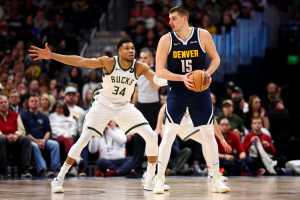
Ranking the NBA's 8 Best International Players of the Last Decade
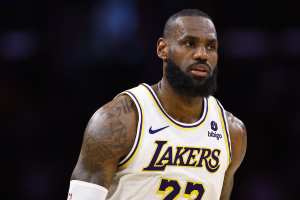
Nikola Jokić, Jayson Tatum, LeBron James Headline 2023-24 All-NBA Teams
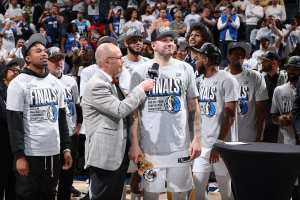
Mavs' Luka Dončić Drops Hype Video Before 2024 NBA Finals Game 1 vs. Tatum, Celtics
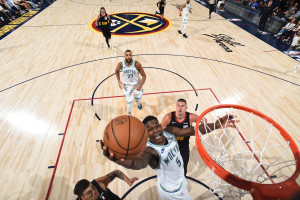
Anthony Edwards, Wolves Stun NBA Fans with 20-Point Rally to Top Jokić, Nuggets in G7
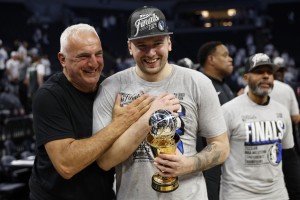
Mavs' Luka Dončić Named 2024 Western Conference Finals MVP After Win vs. Timberwolves
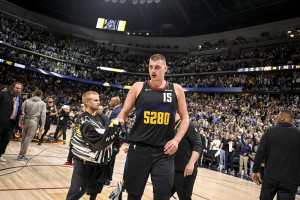
Report: NBA Investigates Nikola Jokić's Brother Punching Fan on Video at Lakers Game
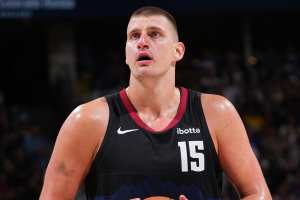
Nuggets' Nikola Jokić, 361 Degrees Reveal Photos of 'SpongeBob' Sneaker Collection
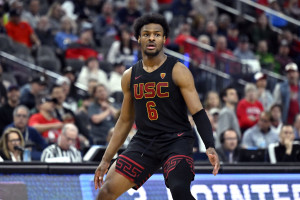
Bronny James' Top Potential Landing Spots After 2024 NBA Draft Lottery
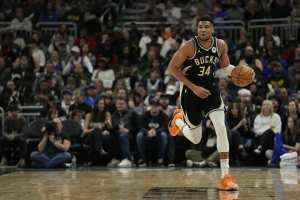
Greece HC: Giannis to Play in Olympic Qualifiers; Injured Star Missed Bucks' Playoffs
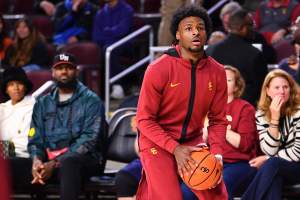
LeBron James Rumors: NBA Teams Discuss Drafting Bronny on Day 1 to Lure Lakers Star



